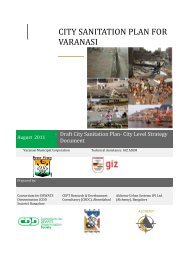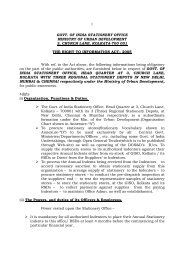CITY SANITATION PLAN - Ministry of Urban Development
CITY SANITATION PLAN - Ministry of Urban Development
CITY SANITATION PLAN - Ministry of Urban Development
You also want an ePaper? Increase the reach of your titles
YUMPU automatically turns print PDFs into web optimized ePapers that Google loves.
<strong>CITY</strong> <strong>SANITATION</strong> <strong>PLAN</strong> BAREILLY<br />
irrigation or for growing plants and is absolutely safe for human use. In certain urban areas the<br />
processed water is taken for use as flush- water in toilets.<br />
Adequacy: This technology is easily adaptable and can be applied at the household level or for a<br />
small neighborhood. An ABR can be designed for a single house or a group <strong>of</strong> houses that are using a<br />
considerable amount <strong>of</strong> water for clothes washing, showering, and toilet flushing. It is mostly<br />
appropriate if water use and supply <strong>of</strong> wastewater are relatively constant. This technology is also<br />
appropriate for areas where land may be limited since the tank is installed underground and<br />
requires a small area. It should not be installed where there is a high groundwater table as<br />
infiltration will affect the treatment efficiency and contaminate the groundwater.<br />
Health Aspects/Acceptance: Although the removal <strong>of</strong> pathogens is not high, the ABR is contained so<br />
users do not come in contact with any <strong>of</strong> the wastewater or disease causing pathogens. Effluent and<br />
sludge must be handled with care as they contain high levels <strong>of</strong> pathogenic organisms. To prevent<br />
the release <strong>of</strong> potentially harmful gases, the tank should be vented.<br />
Maintenance: Adequate arrangements must be made for periodic removal <strong>of</strong> sludge from the first<br />
compartment. Sludge accumulation in the baffled compartments should be much less. Although<br />
desludging at regular intervals is necessary, it is important that some active sludge is left in each <strong>of</strong><br />
the compartments to maintain a stable treatment process. ABR tanks should be checked to ensure<br />
that they are watertight and the levels <strong>of</strong> the scum and sludge should be monitored to ensure that<br />
the tank is functioning well. Because <strong>of</strong> the delicate ecology, care should be taken not to discharge<br />
harsh chemicals into the ABR. The sludge should be removed annually using a vacuum truck to<br />
ensure proper functioning <strong>of</strong> the ABR.<br />
Pros & Cons<br />
Resistant to organic and hydraulic shock loads<br />
No electrical energy required<br />
Can be built and repaired with locally available materials<br />
Grey water can be managed concurrently<br />
Long service life and no real problems with flies or odours if used correctly<br />
High reduction <strong>of</strong> organics<br />
Moderate capital costs, moderate operating costs depending on emptying; can be low cost<br />
depending on number <strong>of</strong> users<br />
ADMINISTRATIVE STAFF COLLEGE OF INDIA, HYDERABAD Page 160
















